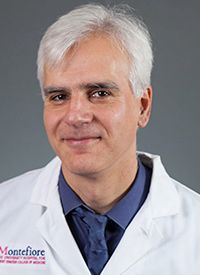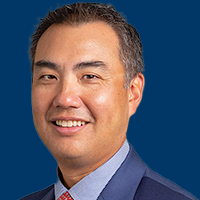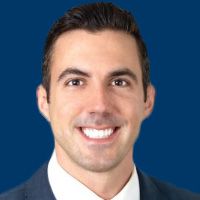Thoracic Clinical Expert Looks at Optimal Ways to Translate Data Into Practice
As oncogene-driven therapies move into clinical practice, it is paramount that clinicians have the tools and understanding to integrate the latest evidence for the appropriate treatment of patients with lung cancer.
Balazs Halmos, MD, MS

As oncogene-driven therapies move into clinical practice, it is paramount that clinicians have the tools and understanding to integrate the latest evidence for the appropriate treatment of patients with lung cancer. Optimizing testing strategies, determining single-agent or combination tactics, balancing novel agents with standard-of-care guidelines, and mitigating treatment-related toxicities represent a few of the challenges in modern thoracic practice.
“The biggest breakthroughs in the past 2 to 3 years have been in the perioperative management of patients with lung cancer and are in neoadjuvant chemotherapy, chemoimmunotherapy, adjuvant immunotherapy, [and] adjuvant targeted therapy. How do we interpret the literature? [It’s] very interesting and important, but also very difficult for the clinicians to make sure that we can understand that information the proper way,” said Balazs Halmos, MD, MS, in an interview with OncologyLive. Halmos is a cochair for the 18th Annual New York Lung Cancers Symposium (NY Lung) hosted by Physicians’ Education Resource, LLC (PER). The 1-day event will be held on November 11, 2023, in New York, New York. Halmos is a professor of clinical medicine, director of thoracic/head and neck oncology, and director of clinical cancer genomics at Albert Einstein College of Medicine/Montefiore Medical Center in Bronx, New York.
“I’ve been the faculty chair for 3 years, but I have to say that I feel very fortunate that I was a regular attendee for 8 to 10 years beforehand,” Halmos said, adding that he was excited to cochair the meeting with Mark G. Kris, MD. Kris is the William and Joy Ruane Chair in Thoracic Oncology at Memorial Sloan Kettering Cancer Center in New York. “NY Lung is my favorite meeting of the year. It brings together a large number of very engaged, very vocal, very opinionated, but at the same time friendly group of clinicians and clinical investigators.”
A Focus on Markers and Resistance
Discussing the rapid pace of development in lung cancer, Halmos said, “Unless someone has been living in a cave for a few decades, you know that each and every year there is a whirlwind of activity that needs to be interpreted.”
He noted that one of the priorities of the symposium is to cover major advances in the field. “The second focus of the conference is not just looking at the data, but looking at the patient that we’ll see next week, how do the data apply to the actual patient? How do we bring it to the clinic in the best possible way, so these advances are translated to optimal patient care?” he said. One such update comes from the overall survival (OS) analysis of the phase 3 ADAURA trial (NCT02511106) of osimertinib (Tagrisso) for the treatment of patients with resected, stage IB-IIIA, EGFR-mutated non–small cell lung cancer (NSCLC).1 Compared with placebo, treatment with the EGFR inhibitor reduced the risk of death by 51% (HR, 0.49; HR, 0.49; 95% CI, 0.34-0.70; P < .001).1
“That was a huge update at the [American Society for Clinical Oncology Annual Meeting], the ADAURA data, and it will be touched upon in a number of different sessions, including the perioperative management [session], as well as [a session dedicated to] EGFR, and the next wave of development there,” Halmos said of the NY Lung agenda. “We’ll definitely cover how to integrate that knowledge into patient management.” Before the treatment selection can be made, however, biomarker selection plays an ever-growing role in the treatment of lung cancers. “We’ll have special sessions on biomarker use and, of course, ADAURA brings that up in a very significant way. We cannot bring the best treatments to our patients unless we complete biomarker testing. And we’ll have 2 speakers looking at how the biomarker field is advancing—especially with circulating tumor DNA looking at MRD [minimal residual disease] testing—and how that that is helping the clinician [and] the anticipated future in the biomarker domain,” he said.
Delving deeper into the biomarker domain includes addressing a major hurdle for prolonged success of targeted agents: acquired resistance in NSCLC.2
“Acquired resistance to our targeted drugs remains a key issue and we’re seeing a lot of exciting developments in the field,” Halmos said. “Specifically [with] EGFR, osimertinib is a standard of care for most patients, but there’s still resistance developing fairly uniformly, maybe a year and a half to 3 [years] after starting therapy.”
Halmos added that in the past year movement has been made with data supporting tactics that can optimize excitement in several different ways. “First, we’re learning how biomarker testing can optimize patient management with ctDNA or tissue-based [testing] thinking about MET amplification—nowadays we can use combination EGFR and MET inhibitors—and we’re seeing a new generation of EGFR TKIs [tyrosine kinase inhibitors] being developed. There’s [also] a lot of excitement about [BLU-945] that might overcome resistance mediated by secondary mutations of EGFR,” he said.
In a study of real-world to assess the incidence of acquired mutations, investigators demonstrated that MET amplification is most seen within the first year of osimertinib treatment in the first-line setting. EGFR C797X was observed within the first year of second-line treatment with osimertinib. Cumulatively, the incidence of EGFR C797X mutations was 12.5% among 600 patients included in the analysis who were likely first-line progressors after osimertinib.3
BLU-945, a reversable, wild-type sparing EGFR inhibitor,4 has demonstrated early signals of reducing resistance mutation alleles (eg, T790M and C797S) when administered in combination with osimertinib. The TKI was evaluated as a single agent and in combination with osimertinib in the phase 1/2 SYMPHONY study (NCT04862780) in patients with EGFR mutant NSCLC with no other known oncogenic tumor drivers. Investigation of dose escalation for the combination is ongoing.4
Building on Advances in Immunotherapy
Halmos noted that with regard to immunotherapy treatment, advances with PD-L1 inhibition have laid the groundwork to identify and optimize these regimens. “Anti–PD-L1 agents have been a breakthrough in our field, but we want to build upon [regimens leveraging that] status and continue to improve the care of our patients,” he said.
Specifically, he referenced findings from the phase 3 CheckMate 227 (NCT02477826), CheckMate 9LA (NCT03215706), and POSEIDON (NCT03164616) studies that have demonstrated efficacy with immunotherapy combinations in patients with stage IV disease. “These studies have brought some new information, as well as FDA approvals, to our field,” he said.
Results of the first 2 trials led to the approval of nivolumab (Opdivo) and ipilimumab (Yervoy) back to back in May 2020.5,6 In CheckMate 227, the combination of nivolumab and ipilimumab was assessed as a first-line treatment for patients with metastatic NSCLC with PD-L1 expression greater than 1%.5 In CheckMate 9LA, the combination was evaluated in combination with 2 cycles of platinum-doublet chemotherapy as first-line treatment for patients with metastatic or recurrent disease.6
Beyond the dual PD-1 inhibition, findings from POSEIDON added CTLA-4 inhibition to the treatment roster. In the study, the CTLA-4 inhibitor tremelimumab (Imjudo) was evaluated in combination with durvalumab (Imfinzi) and platinum-based chemotherapy.7 “We can now use CTLA-4 inhibitors in an FDA-approved and evidence-based fashion. But we’re still struggling to identify the exact patient population where the added toxicity and the added cost of CTLA-4 inhibition [are] appropriate,” Halmos said. “Chemotherapy is still something that we need to understand better. And the data coming from the POSEIDON study are suggestive of the added [value of] CTLA-4 inhibition for patients with a uniquely poor prognosis, such as patients with special mutations—STK11, KIP1, or other negative prognostic markers—who could benefit from those combinations. Patient selection issues are very difficult.”
Other work in this area, according to Halmos, is to leverage findings from post hoc subgroup analyses to identify gaps in efficacy. “Unique sets of patients, [such as] those with TPS [tumor proportion score] score of 0, seem to benefit less from single-agent immunotherapy alongside chemotherapy and could potentially benefit from a more intense drug program, whether that’s combination immunotherapy or combination chemotherapy/immunotherapy. We’re looking forward to some new studies that will address [these topics] so our evidence base can continue to grow,” he said.
Halmos added that expanding immunotherapy to other stages of disease may afford opportunities for these agents. “Up until now, our major focus has been identifying patients with stage IV NSCLC who are the best candidates for immunotherapy or chemotherapy/immunotherapy,” he said. “Now all those questions are being shifted into earlier stage settings as well. The field is in a bit of flux, trying to digest, process, and interpret data properly. This is exactly why a meeting such as NY Lung is so great, so that we can have 200 experts arguing [through these findings] to make sure that we understand the information the best.”
Challenges in National Care
Although the ongoing shortages of cisplatin and carboplatin in the United States have prompted short-term changes and guidelines to address the current situation, long-term strategies and oversight are needed to prevent potential future drug shortages that could affect the treatment of patients with cancer, Halmos said in a follow-up interview with OncologyLive.
“This is a wake-up call. We need to figure out how in the United States, [instead of] a patchwork [system] where everyone is looking out for themselves, we can create a national platform to look out for our patients together,” Halmos said. “It’s great that we’re making big advances with new treatments [such as chimeric antigen receptor] CAR T-cell therapies, bispecific T-cell engagers, and all kinds of checkpoint inhibitors. They’re fantastic. However, not being able to provide drugs such as cisplatin and carboplatin, which are so critically important for patients with head and neck cancer, lung cancer, all kinds of gynecologic cancers, [and more], it’s mind boggling.”
The National Comprehensive Cancer Network has noted that results of a survey of 27 member institutions showed that 93% have reported a shortage of carboplatin and 70% have reported a cisplatin shortage.8 “We have to fix it, and I’m pleased that leadership has started to recognize that this is not something that guidelines [alone] can fix,” Halmos said. “There [has been] an FDA response, trying to fix the shortcomings in terms of the pipeline of these drugs, and, hopefully, there will be a national outline as to how we can prevent these [shortages] in the future.”
References
- Tsuboi M, Herbst RS, John T, et al; ADAURA Investigators. Overall survival with osimertinib in resected EGFR-mutated NSCLC. N Engl J Med. 2023;389(2):137-147. doi:10.1056/NEJMoa2304594
- Chhouri H, Alexandre D, Grumolato L. Mechanisms of acquired resistance and tolerance to EGFR targeted therapy in nonsmall cell lung cancer. Cancers (Basel). 2023;15(2):504. doi:10.3390/cancers15020504
- Ramalingam SS, Zhang N, Yu J, et al. Real-world landscape of EGFR C797X mutation as a resistance mechanism to osimertinib in non-small cell lung cancer. J Thorac Oncol. 2022;17(suppl 9):S67-S68. doi:10.1016/j.jtho.2022.07.113
- Elamin YY, Nagasaka M, Shum E, et al. BLU-945 monotherapy and in combination with osimertinib (OSI) in previously treated patients with advanced EGFR-mutant (EGFRm) NSCLC in the phase 1/2 SYMPHONY study. J Clin Oncol. 2023;41(suppl 16):9011. doi:10.1200/JCO.2023.41.16_suppl.9011
- FDA approves nivolumab plus ipilimumab for first-line mNSCLC (PD-L1 tumor expression ≥1%). FDA. May 15, 2020. Accessed August 21, 2023. bit.ly/3LOODFS
- FDA approves nivolumab plus ipilimumab and chemotherapy for first-line treatment of metastatic NSCLC. FDA. Updated May 27, 2020. Accessed August 21, 2023. bit.ly/45LIbu2
- FDA approves tremelimumab in combination with durvalumab and platinum-based chemotherapy for metastatic non-small cell lung cancer. Updated November 10, 2022. Accessed August 21, 2023. bit.ly/47ZC2fE
- NCCN releases statement addressing ongoing chemotherapy shortages; shares survey results finding more than 90% of cancer centers are impacted. News release. National Comprehensive Cancer Network. August 21, 2023. Accessed June 7, 2023. https://www.nccn.org/home/news/




